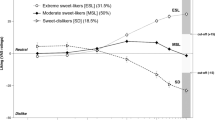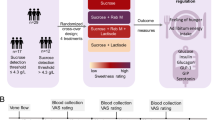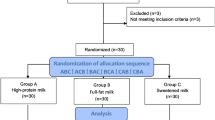Abstract
OBJECTIVE: As a part of the SPAWN (Stockholm Pregnancy and Women's Nutrition) study, the intake of sweet foods (habitual and pre-menstrual intakes) and the number of cariogenic microorganisms in saliva was analysed in relation to body mass index (BMI) and psychometric variables.
DESIGN: A cross-sectional study.
SUBJECTS: Three hundred and sixty-two women with a median BMI of 24.2 kg/m2 (range 17.5–47.8) and 45 y of age (range 34–64).
METHODS: A questionnaire of sweet food intake, salivary counts of mutans streptococci and lactobacilli and a self-rating scale on psychometric variables (CPRS-S-A).
RESULTS: The number of mutans streptococci correlated with BMI (P<0.05), indirectly indicating a higher intake of sweet foods in obese women. The reported energy intake of sweet foods (more specifically the intake of chocolate), correlated with CPRS scores (P<0.01), indicating that women with more severe psychiatric symptomatology have higher intakes of sweet foods.
CONCLUSIONS: This study suggests that women with higher CPRS score have higher energy intakes of sweet foods, indicating a possible link between mood regulation and the intake of sweet food.
SPONSORSHIP: Karolinska Institute Research Funds.
This is a preview of subscription content, access via your institution
Access options
Subscribe to this journal
Receive 12 print issues and online access
$259.00 per year
only $21.58 per issue
Buy this article
- Purchase on Springer Link
- Instant access to full article PDF
Prices may be subject to local taxes which are calculated during checkout
Similar content being viewed by others
References
Bolton-Smith C, Woodward M . Dietary composition and fat to sugar ratios in relation to obesity Int J Obes Relat Metab Disord 1994 18: 820–828.
Drewnowski A, Henderson SA, Shore AB, Fischler C, Preziosi P, Hercberg S . The fat-sucrose seesaw in relation to age and dietary variety of French adults Obes Res 1997 5: 511–518.
Gibson SA . Are high-fat, high-sugar foods and diets conducive to obesity? Int J Food Sci Nutr 1996 47: 405–415.
Miller WC, Lindeman AK, Wallace J, Niederpruem M . Diet composition, energy intake, and exercise in relation to body fat in men and women Am J Clin Nutr 1990 52: 426–430.
Stam-Moraga MC, Kolanowski J, Dramaix M, De Backer G, Kornitzer MD . Sociodemographic and nutritional determinants of obesity in Belgium Int J Obes Relat Metab Disord 1999 23: 1–9.
Macdiarmid JO, Vail A, Cade JE, Blundell JE . The sugar-fat relationship revisited: differences in consumption between men and women of varying BMI Int J Obes Relat Metab Disord 1998 22: 1053–1061.
Macdiarmid JI, Blundell JE . Dietary under-reporting: what people say about recording their food intake Eur J Clin Nutr 1997 51: 199–200.
Mela DJ, Aaron JI . Honest but valid: what subjects say about recording their food intake J Am Dietetic Assoc 1997 97: 791–793.
Macdiarmid JI, Blundell JE . Assessing dietary intake: who, what and why of under-reporting Nutr Res Rev 1998 11: 231–253.
Andréen I, Köhler B . Effects of Weight Watchers' diet on salivary secretion rate, buffer effect and number of mutans streptococci and lactobacilli Scand J Dent Res 1992 100: 93–97.
Karjalainen S, Hämäläinen M, Karhuvaara L, Söderling E . Effects of variations in sucrose consumption on salivary lactobacillus count and sucrase activity in man Acta Odontol Scand 1987 45: 289–296.
Kristoffersson K, Birkhed D . Effects of partial sugar restrictions for 6 weeks on number of Streptococcus mutans in saliva and interdental plaque in man Caries Res 1987 21: 79–86.
Scheie AA, Arneberg P, Orstavik D, Afseth J . Microbial composition, PH-depressing capacity and acidogenicity of 3-week smooth surface plaque developed on sucrose-regulated diets in man Caries Res 1984 18: 74–86.
Barkeling B, Andersson I, Lindroos A-K, Birkhed D, Rössner S . Intake of sweet foods and counts of cariogenic microorganisms in obese and normal-weight women Eur J Clin Nutr 2001 55: 850–855.
Mela DJ, Rogers PJ . Mood, food craving and food addiction as causes of overeating In: Mela DJ, Rogers PJ (eds) Food, eating and obesity Chapman & Hall: London 1998.
Christensen L . The effect of carbohydrates on affect Nutrition 1997 13: 503–514.
Rogers PJ, Smit HJ . Food craving and food ‘addiction’: a critical review of the evidence from a biopsychosocial perspective Pharmac Biochem Behav 2000 66: 3–14.
Rooth P, Hyll M, Rössner S . High prevalence of anxiety and depressive symptoms in obese patients 9th European Congress on Obesity, Milano, Int J Obes Relat Metab Disord (Suppl 5): 1999 S159.
Lissner L, Johansson S-E, Qvist J, Rössner S, Wolk A . Social mapping of the obesity epidemic in Sweden Int J Obes Relat Metab Disord 2000 24: 801–805.
Öhlin A, Rössner S . Maternal body weight development after pregnancy Int J Obes 1990 14: 159–173.
Öhlin A, Rössner S . Trends in eating patterns, physical activity and sociodemographic factors in relation to postpartum body weight development Br J Nutr 1994 71: 457–470.
Lindroos A-K, Lissner L, Sjöström L . Validity and reproducibility of a self-administered dietary questionnaire in obese and non-obese subjects Eur J Clin Nutr 1993 47: 461–481.
Möller AJR . Microbiological examination of root canals and periapical tissues of human teeth. Thesis Odontol Tidskr 1966 74: 1–380.
Gold OG, Jordan HV, Van Houte J . A selective medium for Streptococcus mutans Arch Oral Biol 1973 18: 1357–1364.
Emilson CG . Prevalence of streptococcus mutans with different colonial morphologies in human plaque and saliva Scand J Dent Res 1983 91: 26–32.
Svanborg P, Åsberg M . A new self-rating scale for depression and anxiety states based on Comprehensive Psychopathological Rating Scale Acta Psychiatr Scand 1994 89: 21–28.
Mattila-Evenden M, Svanborg P, Gustavsson P, Åsberg M . Determinants of self-rating and expert rating concordance in psychiatric out-patients, using affective subscales of the CPRS Acta Psychiatr Scand 1996 94: 386–396.
American Psychiatric Association. Diagnostic and Statistical Manual of Mental Disorders–DSM-IV 1994.
Van Palenstein Helderman WH, Matee MI, Van der Hoeven JS, Mikx FH . Cariogenicity depends more on diet than the prevailing mutans streptococcal species J Dent Res 1996 75: 535–545.
Rosenthal NE, Sack DA, Gillin JC, Lewy AJ, Goodwin FK, Davenport Y, Mueller PS, Newsome DA, Wehr TA . Seasonal affective disorder. A description of the syndrome and preliminary findings with light therapy Arch Gen Psychiat 1984 41: 72–80.
Takahashi K, Asano Y, Kohsaka M, Okawa M, Sasaki M, Honda Y, Higuchi T, Yamazaki J, Ishizuka Y, Kawaguchi K . Multi-center study of seasonal affective disorders in Japan. A preliminary report J Affect Disord 1991 21: 57–65.
Christensen L, Pettijohn L . Mood and carbohydrate craving Appetite 2001 36: 137–145.
Wurtman RJ . Dietary treatments that affect brain neurotransmitters: effects on calorie and nutrient intake In: Wurtman RJ, Wurtman JJ (eds) Human obesity. Annals of the New York Academy of Sciences: New York 1987 pp 179–189.
Fernstrom JD . Carbohydrate ingestion and brain serotonin synthesis: relevance to a putative control loop for regulating carbohydrate ingestion and effects of aspartame consumption Appetite 1988 11 (Suppl): 35–41.
Drewnowski A . Food preferences and the opioid peptide system Trends Food Sci Technol 1992 3: 97–99.
Johnson TM . Premenstrual syndrome as a western culture-specific disorder Cult Med Psychiat 1987 11: 337–356.
Paige KE, Paige JM . Politics and reproduction rituals University of California Press: Berkeley, CA 1981.
Acknowledgements
The authors acknowledge Viveca Petre Larsson, Birgitta Spetz, Lena Mannström Svensson and Karin Östling for their enthusiastic support and help in this study.
Author information
Authors and Affiliations
Corresponding author
Rights and permissions
About this article
Cite this article
Barkeling, B., Linné, Y., Lindroos, A. et al. Intake of sweet foods and counts of cariogenic microorganisms in relation to body mass index and psychometric variables in women. Int J Obes 26, 1239–1244 (2002). https://doi.org/10.1038/sj.ijo.0802034
Received:
Revised:
Accepted:
Published:
Issue Date:
DOI: https://doi.org/10.1038/sj.ijo.0802034
Keywords
This article is cited by
-
Impact of Bariatric Surgery on the Saliva of Patients with Morbid Obesity
Obesity Surgery (2015)
-
Clinical and biological indicators of dental caries and periodontal disease in adolescents with or without obesity
Clinical Oral Investigations (2014)
-
The Human Sweet Tooth
BMC Oral Health (2006)



